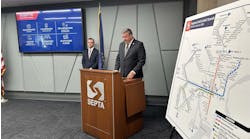New U.S. DOE research shows investment in transit service would result in more transit use throughout Chicago, Ill.
New research led by the U.S. Department of Energy’s (DOE) Argonne National Laboratory (ANL) found a robust investment in transit service would result in a 53 percent increase in transit boardings in the Chicago, Ill., region (Chicago Transit Authority (CTA), Metra and Pace), with nine percent travel time savings and an 11 percent reduction in greenhouse gas emissions.
“Transit has profound effects on the daily lives of Chicagoans, whether they travel by bus, rail or car,” said CTA President Dorval R. Carter, Jr. “Investing in transit service supports equitable outcomes for Chicago’s diverse communities, spurring changes in activities, vehicle miles traveled and pollution reduction across the city’s neighborhoods.”
ANL modeled policy changes and infrastructure investments along with an increase in transit service in line with the investment levels proposed by the Chicago Metropolitan Agency for Planning’s PART study. ANL considered changes in service (like completing the Red Line Extension project in south Chicago), infrastructure supportive of transit (bus rapid transit and bus priority lanes, speed policy), increasing overall service frequencies and regional development (transit-oriented population shift). CTA says the new research shows that with additional funding, at amounts that are currently in discussion among state legislators, will grow transit ridership through added service while also reducing travel times for all travel modes, including cars.
“Transit ridership increase is critical in supporting the economy and improving mobility and equity,” said Aymeric Rousseau, Argonne Vehicle and Mobility Systems Department director. “Considering the transportation system as a whole, including technologies, policies, land use and travel behavior, is necessary to help guide future decisions.”
CTA notes the modeling presented shows that a robust investment in transit creates a huge, generative effect for the region with nearly $19 billion in annual household savings, a 13-time return on the investment in service provided. The data additionally shows:
- A 12 percent increase in activities (Chicago)
- A 11 percent reduction in particulate matter emissions
- A 15 percent reduction in regional vehicle miles traveled
- An equitable share of benefits experienced across race, gender and Chicago neighborhoods
CTA says the analysis shows it is possible to benefit all transportation modes by investing in transit. ANL’s modeling showed a 43 percent increase in mode share for transit in the long term, with an additional 16 percent mode share for active modes (like walking and biking) and a 14 percent reduction in driving.
“A region with robust, consistent transit investment and policies that prioritize transit is truly visionary and ANL's data shows that if given a chance, there can be meaningful mode shift and equitable mobility outcomes, without hurting walking, biking or cars,” Carter said.
CTA notes previous research from ANL and the Massachusetts Institute of Technology (MIT) showed the Chicago region would face severe consequences if its public transportation system was eliminated, including increased vehicle congestion, reduced economic activity and a disproportionate impact on underserved communities and minorities. The removal of public transit would also have public health repercussions. Increased vehicle traffic would lead to higher emissions of a type of particulate matter demonstrated to increase respiratory disease, heart attacks and strokes.
The agency says the research by ANL and MIT showed the region’s transit system saves households more than $35 billion in avoided costs per year – and without the robust transit system that is currently in place, more than 2 million household activities would be cancelled annually.
The project was funded through DOE’s Office of Policy and Vehicle Technologies Office in the Office of Energy Efficiency and Renewable Energy.




